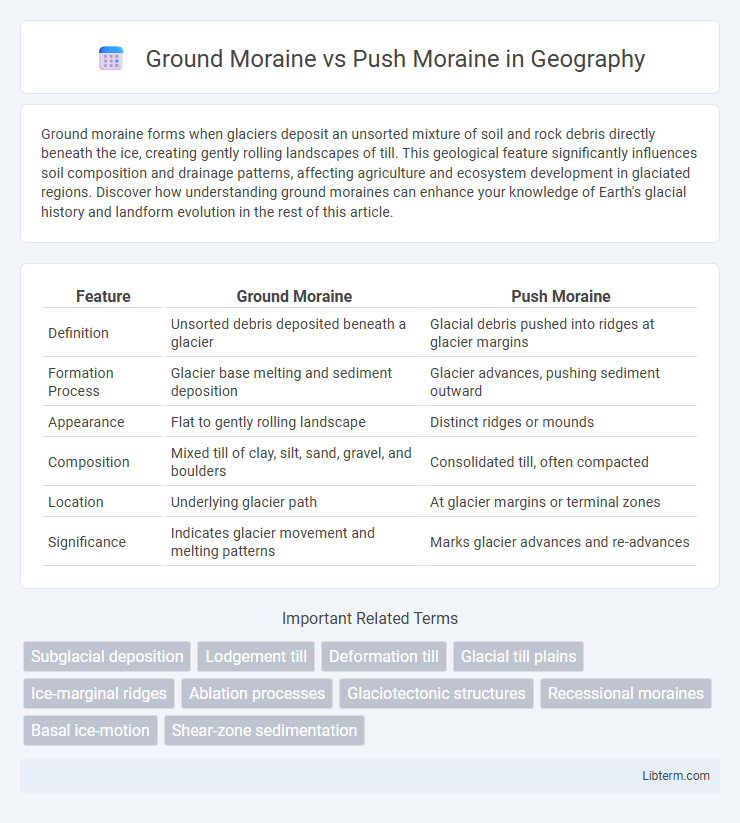Ground moraine forms when glaciers deposit an unsorted mixture of soil and rock debris directly beneath the ice, creating gently rolling landscapes of till. This geological feature significantly influences soil composition and drainage patterns, affecting agriculture and ecosystem development in glaciated regions. Discover how understanding ground moraines can enhance your knowledge of Earth's glacial history and landform evolution in the rest of this article.
Table of Comparison
| Feature | Ground Moraine | Push Moraine |
|---|---|---|
| Definition | Unsorted debris deposited beneath a glacier | Glacial debris pushed into ridges at glacier margins |
| Formation Process | Glacier base melting and sediment deposition | Glacier advances, pushing sediment outward |
| Appearance | Flat to gently rolling landscape | Distinct ridges or mounds |
| Composition | Mixed till of clay, silt, sand, gravel, and boulders | Consolidated till, often compacted |
| Location | Underlying glacier path | At glacier margins or terminal zones |
| Significance | Indicates glacier movement and melting patterns | Marks glacier advances and re-advances |
Introduction to Ground Moraine and Push Moraine
Ground moraine consists of unsorted glacial debris deposited beneath a glacier, creating a gently rolling landscape of till. Push moraine forms when a glacier advances, actively pushing previously deposited sediments into ridges or mounds. These distinct depositional features reveal varying glacial dynamics and sediment transport processes during glaciation.
Definition and Formation of Ground Moraine
Ground moraine consists of an unsorted mixture of clay, sand, gravel, and boulders deposited directly under a glacier as it retreats, forming a gently rolling landscape. It forms through the continuous melting of the glacier's base, which drags and drops debris onto the bedrock, creating a widespread, hummocky terrain. In contrast, push moraine results from the glacier advancing and actively pushing previously deposited sediments into ridges or mounds.
Definition and Formation of Push Moraine
Push moraines form when advancing glaciers actively push and pile up sediments into ridges at their margins, distinct from ground moraines which consist of unsorted debris deposited as glaciers melt and retreat. Unlike the relatively flat, smooth surface of ground moraines, push moraines exhibit pronounced, linear ridges created by glacial compression and thrusting of till and underlying materials. The process of push moraine formation involves mechanical deformation and displacement of sediments due to glacier advancement, highlighting dynamic glacial movement rather than passive sediment deposition.
Key Differences Between Ground Moraine and Push Moraine
Ground moraines consist of unsorted glacial till deposited beneath a glacier, forming gently rolling landscapes with fine sediments. Push moraines form when advancing glaciers thrust existing sediments into ridges or mounds, creating distinct, often steep ridges composed of compacted till. The key differences lie in formation processes--ground moraines result from depositional accumulation, while push moraines are deformational features created by glacial thrusting.
Sediment Composition in Ground Moraine vs Push Moraine
Ground moraines primarily consist of unsorted glacial till composed of a heterogeneous mixture of clay, silt, sand, gravel, and boulders deposited directly beneath a glacier. Push moraines exhibit a more stratified sediment composition, with deformed and compacted till layers that reflect the glacier's advancing and pushing action, often containing distinct bands of sorted and compressed material. The sediment fabric in push moraines tends to show strong structural deformation, unlike the relatively homogenous and unconsolidated nature of ground moraine deposits.
Landform Characteristics and Geomorphology
Ground moraines consist of unsorted glacial till deposited beneath a glacier, creating gently rolling or flat landscapes with subtle irregularities caused by till compaction and differential melting. Push moraines form at a glacier's leading edge when advancing ice thrusts and deforms pre-existing sediments, resulting in prominent ridges or mounds with steep slopes and chaotic stratification. The contrasting geomorphology reflects depositional processes, where ground moraines indicate basal sediment accumulation and push moraines signify compressive glacial thrusting and reworking.
Examples and Global Distribution
Ground moraines commonly form extensive, gently rolling landscapes such as the Central Lowlands of the United States and the Canadian Prairies, where glaciers deposited unsorted till beneath retreating ice sheets. Push moraines, characterized by ridges of deformed till pushed forward by advancing glaciers, are prominently found in regions like the Scandinavian Ice Sheet margins, including southern Sweden and parts of Finland. Globally, ground moraines dominate large continental interiors shaped by Pleistocene glaciations, while push moraines are mainly localized near active glacier lobes and ice margins in northern Europe and parts of North America.
Ecological and Environmental Impact
Ground moraines create gently undulating landscapes that support diverse ecosystems by providing nutrient-rich soils conducive to various plant species and habitats. Push moraines, formed by glacier advance, often result in steeper, more unstable landforms leading to increased erosion and disrupted drainage patterns, which can negatively affect local flora and fauna. The contrasting soil composition and topography between ground and push moraines significantly influence biodiversity, water retention, and carbon sequestration capabilities in glacial environments.
Role in Glacial Landscape Evolution
Ground moraines form from the accumulation of unsorted glacial till deposited directly beneath a glacier, creating gently rolling landscapes that record the glacier's basal activity and retreat patterns. Push moraines develop when advancing ice sheets force existing sediment and debris forward, producing distinct ridges that indicate episodic glacial advances and serve as markers of dynamic ice margin fluctuations. The contrasting formation processes of ground and push moraines provide critical insights into the temporal and spatial evolution of glacial landscapes, revealing past ice movement behaviors and climatic conditions.
Summary: Importance of Understanding Moraine Types
Understanding the distinctions between ground moraine and push moraine is crucial for interpreting glacial landforms and reconstructing past ice movement. Ground moraine consists of unsorted debris deposited as glaciers retreat, while push moraine forms from sediment pushed forward by advancing ice, creating ridges. Accurate identification of these moraine types enhances geological mapping and informs studies on glacial dynamics and climate change.
Ground Moraine Infographic

 libterm.com
libterm.com